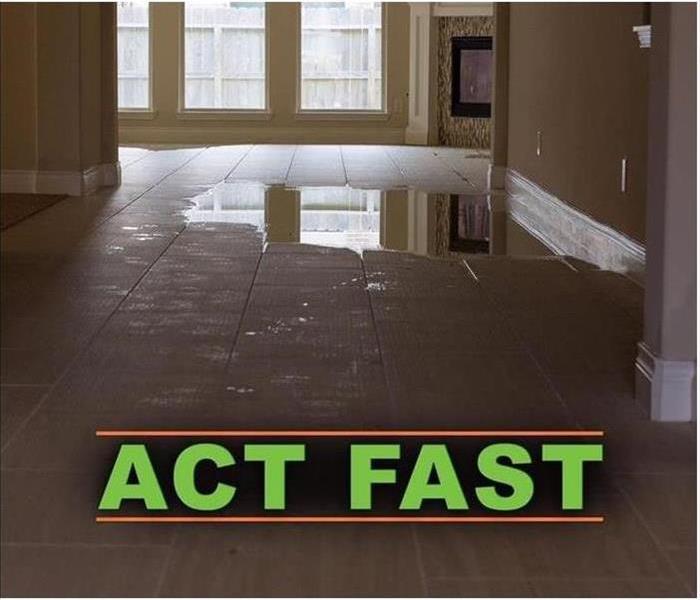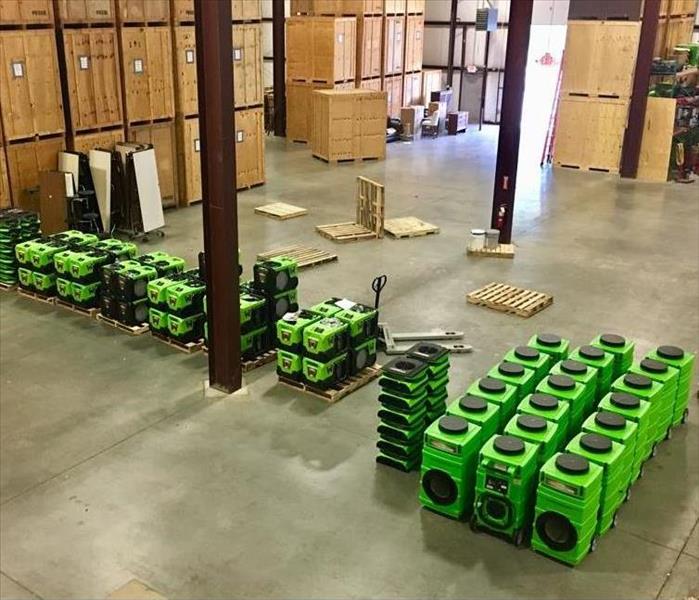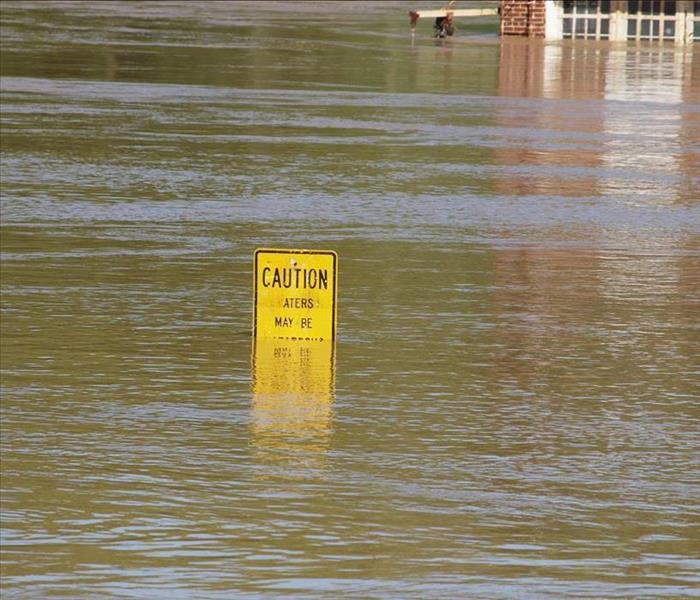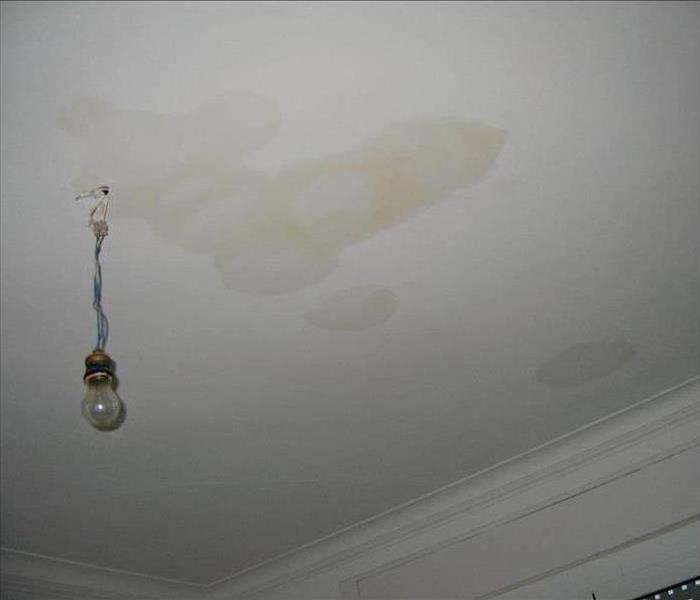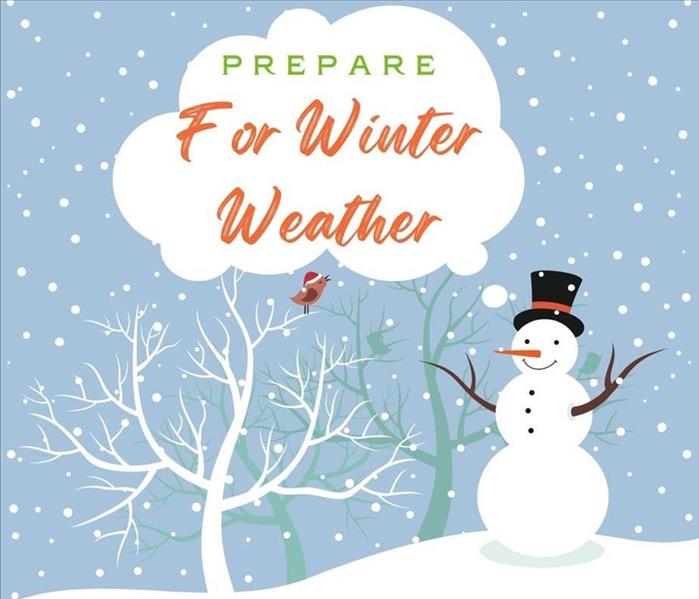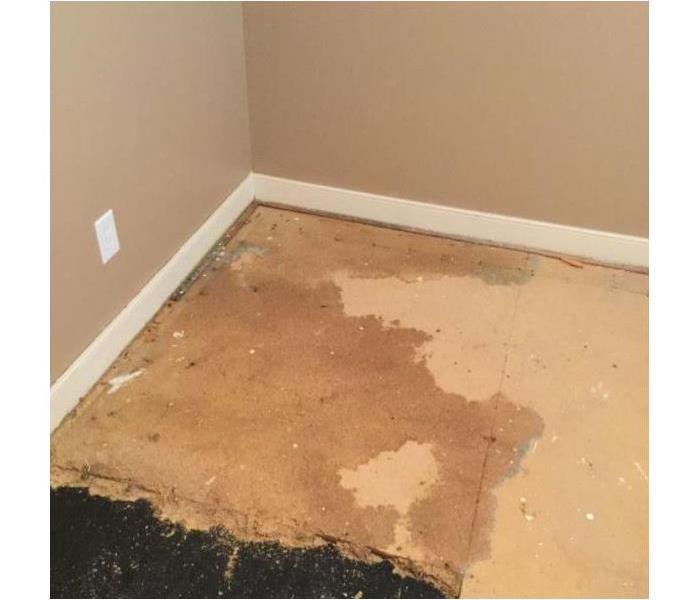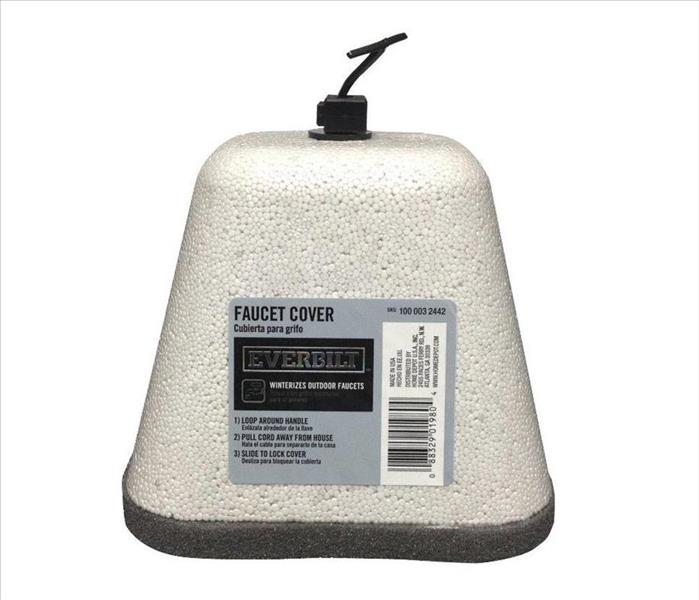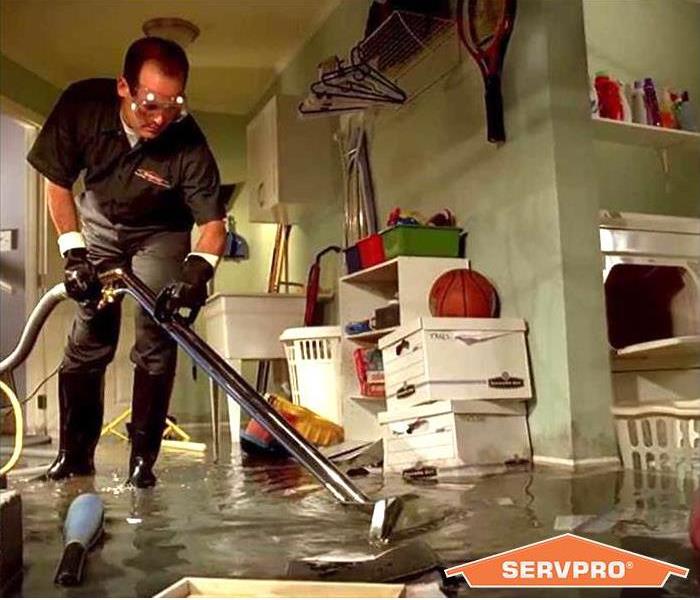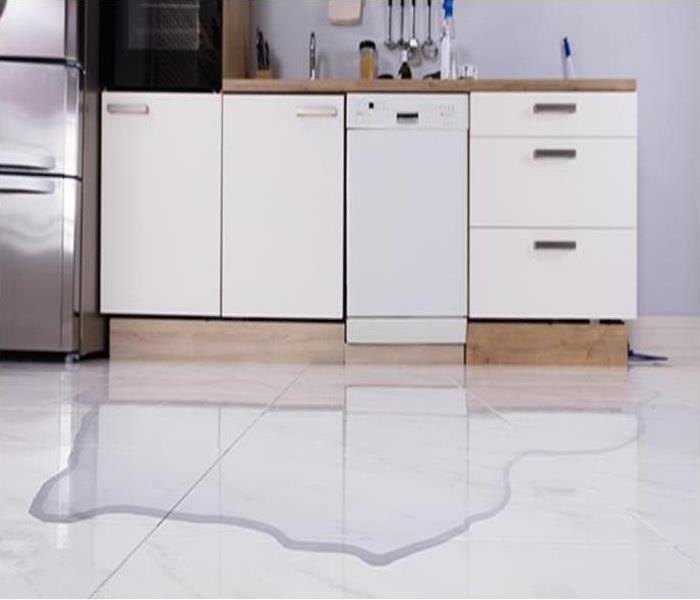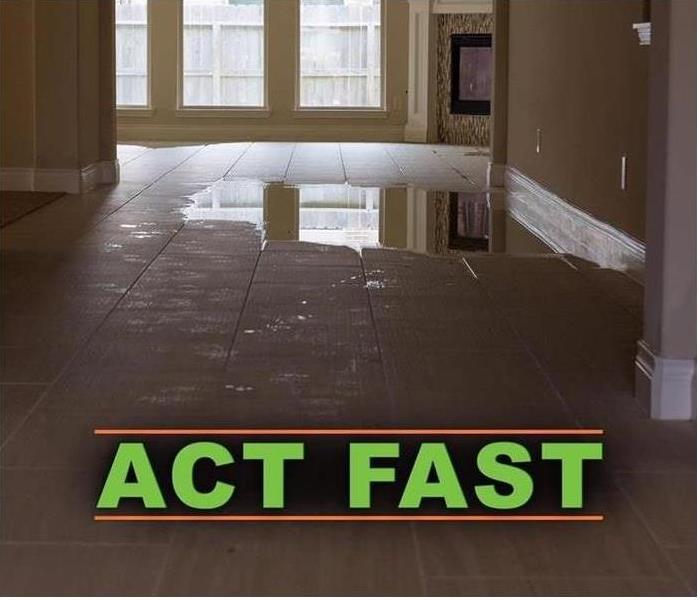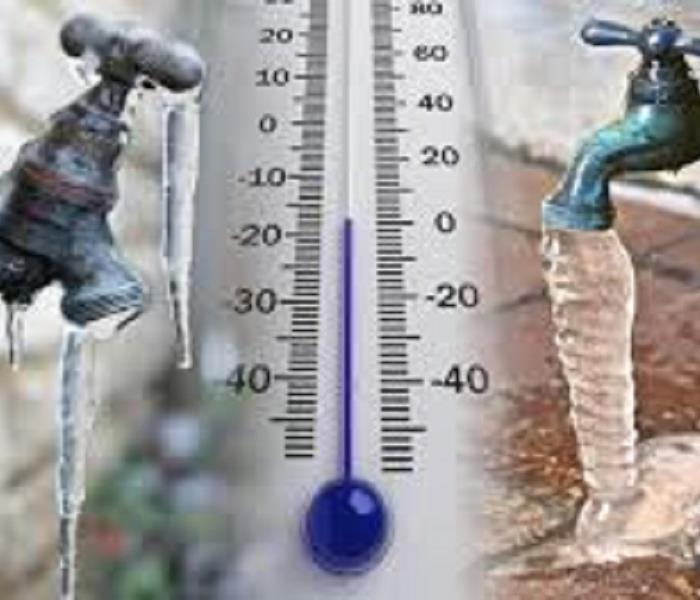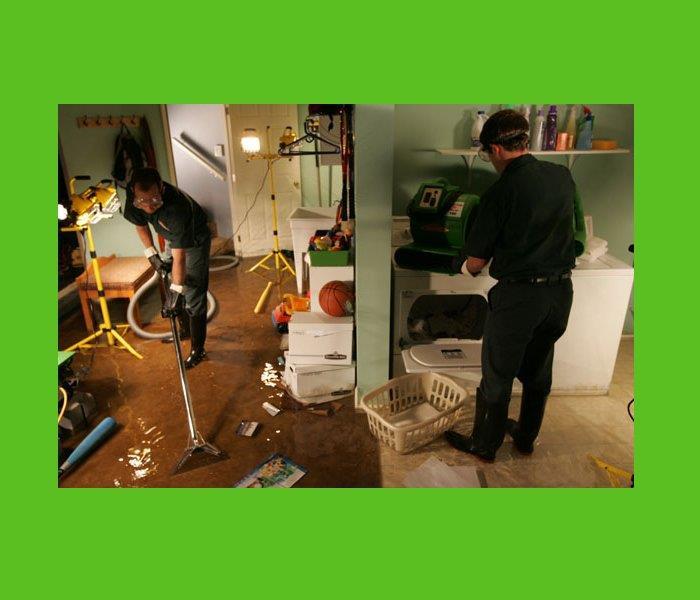Recent Water Damage Posts
Water Damage in your home
7/17/2024 (Permalink)
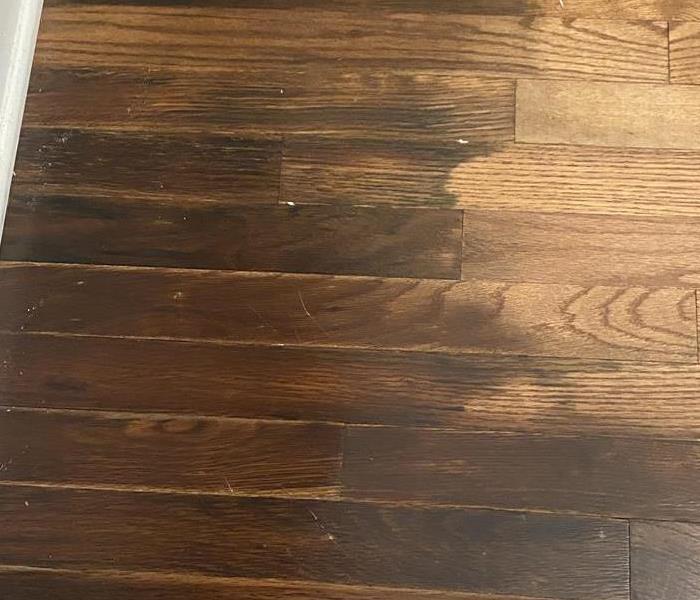 Hardwood floors after water damage
Hardwood floors after water damage
When your home experiences water damage, besides the structural concerns, one of the biggest can definitely be your hardwood floors. Hardwood floors are expensive and add both cosmetic and monetary value to your home so, if possible, you obviously want to try and avoid ripping them out and replacing them. There are multiple factors that can play a part in our ability to restore your floors to preloss conditions:
• Moisture Levels – Hardwood floors have a very low moisture content. When water pools on them for long periods of time the moisture gets soaked into the wood and can take weeks to dry out on its own. This can cause the wood to buckle, have raised edges or have the panels separate from each other.
• Time – The type of wood in question plays a role in how quickly water is absorbed and then dried out. Wood rot happens when microbial growth in water is left without treatment in wood and begins to breakdown the wood.
As you can see, there are quite a few factors that decide whether or not you will have to replace your expensive hardwood floors or not, and that it’s best left to the professionals to handle to help increase your odds of restoration. So, if you find yourself in need of water damage restoration, don’t delay and give us a call asap. Our team is waiting to see how we can help you today.
With the correct equipment and training it is possible to save your floors from having to be removed, so it is imperative that you call a professional restoration company like us here at SERVPRO of Newport News at 757-465-9700.
Removing Water From Your Home
9/26/2022 (Permalink)
When water invades your home, quick action needs to be taken in order to get matters under control and your life back to normal. When water is left to soak into and remain, the greater the water damage and the repair.
SERVPRO of Chesapeake, Portsmouth, Norfolk West, and Hampton North handles water damage with an inventory of equipment with large and powerful pumps that we can submerge enabling a quicker extraction of the floodwater. Our machinery will raise the interior temperature so that evaporation happens at a precise rate.
Our trained technicians and supervisors determine the best drying method to utilize to maintain the quality of the water-damaged area and product. For instance, if a wooden floor is dried out too quickly or with extreme temperatures, the floor can be ruined. Our motto is to restore, not replace. So, we work diligently to help ensure that we can save as much of the structure and belongings of the home as possible. This is beneficial to not only the homeowner but to your insurance company too as it helps to save money.
After the extractor has removed the water, smaller hand-held equipment is used to remove the remaining water found in crevices and baseboards. Once the water has been removed, the drying process begins for the remaining surface dampness and porous household items with the use of our desiccant machines and air movers. An Air Scrubber, our portable filtration system can be used to help clean the air of any contaminants such as dust, gasses, or chemicals in any area.
If you need help with water damage in your home, SERVPRO is here to help.
Water Damage Tools
1/28/2022 (Permalink)
It can be tempting when there is water damage to your home, to want to just mop everything up and make sure the surfaces are dry and call it a day. In reality, this is something you should never do. Water has a way of getting into anything and everything that it touches. Anything porous will suck it up and moisture will be retained hidden inside of the materials, or it can get behind the walls and soak your insulation. This can cause serious problems because if left untreated these spots of moisture can slowly wreak havoc on your home.
Here at SERVPRO of Chesapeake North our skilled technicians are trained to seek out and dry out all of the hidden moisture in your home after water damage occurs. We use specialized equipment to check humidity, temperature, and moisture content of the materials in your home. These proven methods help to ensure that your home is actually completely dry, and the damage has been stopped.
- Moisture Sensors – These are used to detect moisture in carpets, padding and subfloors
- Moisture Meters – This is used to measure the moisture content in various different materials with either a probe or surface detector
- Hydrometers – A tool used to measure temperature and relative humidity in your home. This helps to make sure that the drying process is moving along as efficiently as possible
As you can see, there’s more to it than just mopping up the water that you can see and making sure the surfaces are dry. These tools are critical in making sure that the potential hidden water in your home is gone to prevent further water damage and microbial growth from happening in places that you can’t see.
The Effects of Water Damage Timeline
11/18/2021 (Permalink)
In the restoration industry, we always preach that responding fast to water damage in your home or business is crucial to the damage mitigation efforts, but just how fast does water cause damage?
Immediately After Water Damage
- Water spreads quickly, saturating anything it comes into contact with
- Paper materials will rapidly begin to break down and deteriorate
- Porous materials such as insulation, fabric, upholstery, and wood will start to absorb water
24 Hours After Water Damage
- Paper materials are typically unsalvageable at this point
- Drywall and other structural materials like wood and insulation start to show signs of extended water exposure like bowing and swelling
- Colors can start to bleed from fabrics
- Carpet and upholstery are soaked through
- Musty odors are present and mold growth is a concern
48 Hours After Water Damage
- Mold may be visible on surfaces and micro-organisms may begin growing making the water a health concern
- Wood is full of moisture and the weight causes warping
- Drywall, furniture, carpet, and other fabric items show signs of prolonged exposure and may no longer be salvageable
- Metal begins to corrode
One Week After Water Damage
- Water is now considered Category 3 (Black water)
- Many items if not all of them inside the building will be unsalvageable
- Restoration requirements and costs are greatly increased as the severity of the structural damage will require rebuilding to achieve preloss conditions
- Mold has become its own completely separate issue as the spores have likely spread throughout the building, not limited to just the affected area
As you can see, the state of a building suffering from water damage rapidly declines in a matter of days and in some instances, hours, which is why you should trust your local SERVPRO of Chesapeake North with your water damage restoration. We respond faster to any size disaster, so give us a call and let us know how we can help.
Types of Water Damage
11/9/2021 (Permalink)
Water damage comes in all shapes and sizes, and no job is just like another. Damage is split into three different categories based off on the type of water that has caused the damage as well as four different classes based on the severity of the damage.
Categories
Category One — This category is for clean water with no contaminants or threat of sickness from it. This includes water from broken appliances, water heaters, and water supply line breaks.
Category Two — Category two is for grey water. Grey water is water that has been contaminated in some way and could potentially cause illnesses if ingested. This includes things like dishwasher overflow, washing machine overflow, and other cases where the water is a likely host for growth of microorganisms.
Category Three — This is the highest level for water damage, caused by black water. Black water is water that is grossly unsanitary, containing things like animal or human waste, and can cause serious injury if ingested. Category three damage includes things like sewer backups, flood waters from rivers or streams, standing water that has started to support microbial growth.
Classes
Class One — This is the least severe of all the water damage classes. Only a portion of a room is affected and there is little to no carpet to restore. Class one includes damage to materials with low permeability like plywood and concrete
Class Two — This is water damage that affects a whole room and includes items like carpet and cushions. Water has wicked up the walls at least 12 inches and moisture has affected structural materials.
Class Three —This includes items with the fastest absorption rate. Ceilings, walls, insulation, and carpets are saturated. It may have come from above like a hole in the roof, or wicked up the walls at least two feet.
Class Four — Class four water damage is the worst of all the classes and may sometimes take more specialized remediation methods as it includes deep pockets of moisture in items with low permeability like hardwood and concrete.
Regardless of the category or class it is very important that you address any water damage as soon as possible, which is why we at SERVPRO of Chesapeake North respond faster to any size disaster. Category One, Class One damage can quickly move up in both category and class if left untreated so if you encounter any water damage in your home or business be sure to give us a call!
How to Find Signs of Water Damage in Your Home
10/25/2021 (Permalink)
Make sure you keep an eye out in your home for signs of water damage. It's important to act fast!
SERVPRO of Chesapeake North's professional experience understands that the longer it takes to address water damage, the worse the situation gets. If slow to act, more damage is done to your home's floors, walls, ceilings or other important structural areas.
Here are the main signs of water damage in your home?
- Warping in your hardwood and laminate flooring
- Water rings or brownish or yellowish staining on your walls and ceiling
- Look our for soft, saggy, bubbling in your ceiling
- Be aware of damp, squishy carpet
If you experience any of these signs, make sure to call plumbing professionals to take care of your leaks. Once the problem is solved, give us a call here at SERVPRO of Chesapeake North to start the mitigation and restoration process.
Is Your Chesapeake Home Ready for Winter Weather?
10/15/2021 (Permalink)
With winter fast approaching and colder weather on the way, is your home ready to keep you and your family dry? Check out these best practices to help prevent winter water damage to your home!
- Prevent frozen pipes and pipe bursts
- Any faucets that are connected to pipes in areas that are unheated (attic, crawl space, outside) are more likely to freeze when the temperature drops. Be sure to let cold water drip from those faucets to help prevent freezing.
- If you plan on leaving your home for multiple days during freezing temps leave your heat on. Heating costs may rise a bit, but comparatively to a burst pipe in your home you’ll be happy you did.
- Prevent ice dams
- When warm air from your home heats the roof and melts the snow on the roof it collects in unheated areas and refreezes, making ice dams that limit drainage off the roof and can cause damage to your home.
- Make sure to clear your gutters and downspouts so that water can drain off the roof and doesn’t collect anywhere to refreeze
- Install gutter screens to help keep out debris build up in gutters
- If you live in an area with especially large amounts of snowfall, consider installing snow guards to prevent snow accumulation on your roof and lining under your shingles to prevent leaks as snow melts
- Ensure you know where and how to shut off your water in case of an emergency
- When pipes freeze or burst it is important to be able to respond immediately and prevent the issue from getting any worse. Make sure that you know where your water shut off is and turn it off the second you discover a leak
While the cold weather can bring potential damage to your home, taking the proper steps to get ready can help you enjoy the winter wonderland stress free, and if disaster does happen rest assured that us here at your local SERVPRO are ready to help you make it “Like it never even happened.”
Use SERVPRO to Handle Your Water Damage
10/1/2021 (Permalink)
Water Damage must be addressed by professionals.
Using a restoration company with the experience, knowledge and certifications to handle extensive water damage is extremely important to consider. The professionals are able to dry out your home as soon as possible and do it properly. If you decide to do the remediation on your own, you can easily make mistakes that can cause more challenges, unaddressed damage, higher costs, and even mold growth. Moist and wet areas that are left for more than 48 hours are the perfect conditions for growth to form.
Our SERVPRO of Chesapeake North team will use specialized drying equipment to dry out the damage properly and efficiently. Our team of professionals will closely monitor the process, while keeping you updated every step of the way. Your home’s moisture and humidity levels will also be taken into consideration to ensure that everything will be restored back to its normal condition as soon as possible.
If you’re experiencing water damage in your home or business, contact SERVPRO of Chesapeake North at 757-465-9700.
Cover Your Outdoor Water Faucet This Winter
1/28/2021 (Permalink)
Our team at SERVPRO of Chesapeake North wants you and your family to avoid potential disasters this winter. It's important to take the proper precautions when it comes to your outdoor water faucets to prevent frozen pipes and water damage in your home or crawl space.
Follow These Quick Steps Below:
- The first step to prepare your outdoor faucets is to remove the attached hoses
- Second - drain what's left inside the hose and then store in a shed or garage to avoid freezing.
- Purchase a simple and affordable faucet cover from your local hardware store as seen in the picture.
- Place the faucet cover over the faucet and make sure it is secure up against the wall to keep the faucet insulated, avoiding it from freezing.
If you experience burst pipes this winter causing water damage to your home or business, call the professionals at SERVPRO of Chesapeake North at 757-465-9700.
Water Damage to Your Property
10/26/2020 (Permalink)
After the plumber has fixed the leak, the flooding has subsided, or the fire department has left, getting your structure and your belongings properly dried and cleaned is crucial to a quick and successful restoration.
Moisture can cause mildew, fungus, and mold to grow and can attract insects, termites and even rodents. These factors can destroy the very foundation of a home and your belongings.
At SERVPRO of Chesapeake North, we have the expertise and equipment to properly restore your property after water damage to your home or business. Our experience and scientific approach to water removal and water cleanup enable us to properly dry and restore your property, and your assets.
Every water damage incident varies and requires its own unique solution, however our restoration process stays the same. Want to know what to expect? Check out our process here.
SERVPRO of Chesapeake North has been helping families and businesses in Hampton Roads since the 90’s. Call us at 757-465-9700.
Tips for Handling Water Damage
10/14/2020 (Permalink)
If you experience a water damage in your home, our SERVPRO of Chesapeake North team understands the stress and uncertainty that comes with it. That's why we want to give you some tips and tricks you can do at home before the professionals arrive.
- Locate and shut off the water valve at the source if applicable
- Remove and soak up excess or standing water by mopping and laying down towels
- Remove and prop up wet upholstery and cushions against walls for even drying.
- Place aluminum foil or wood blocks under furniture legs to help stop the damage from affecting furniture
- Remove Oriental or other colored rugs from wet carpeting and place in a dry location
- DO NOT use a regular vacuum to remove water.
- DO NOT turn on ceiling fixtures if ceiling is wet, and keep out of areas where ceilings are sagging from retained water.
- Collect important papers Do not leave books, magazines or other colored items on wet carpeting.
Please call SERVPRO of Chesapeake North at 757-465-9700 to professionally handle the water damage and mitigation process in your home or business.
How to Know if Water Damage is Covered
10/12/2020 (Permalink)
You’ve been cleaning up around the house, your dishwasher has been running and you walk in to the kitchen to find standing water at the base of the dishwasher. Naturally, you clean up the water mess. Next day, you notice that the flooring has buckled. Will your homeowner's insurance cover the cost to fix the flooring?
Most likely because this water damage was sudden and accidental which standard homeowner's insurance policies usually provide this kind of protection. Same holds true if the water heater ruptures or a water pipe bursts and damages the drywall or the ceiling.
What May Not Be Covered
- Damage from an unresolved maintenance issue-the flooring from this dishwasher leak should be repaired or replaced, but if you've had a continuous leak near a faucet or other plumbing fixtures, it may not be covered.
- The Cause of the Water Damage Loss-Most insurance policies will cover the cost to repair the damage, but you shouldn't count on the insurance company replacing the culprit, like the dishwasher.
- Sewer or Drain Water Backup- If water backs up into your home through an outside sewer or drain line, more than likely you have no coverage. You may be able to purchase additional coverage to protect you from this kind of emergency disaster.
- Flood-No type of flood damage is protected by your standard homeowners’ policy. Whether the flooding occurred as a result of a storm, or a water surge, it does not matter. You can purchase a separate flood insurance policy, however, depending on your location, and your mortgage company, a flood insurance policy may be required when buying a home.
Contact us with any questions or concerns about water damage caused by a flood at SERVPRO of Chesapeake North, 757-465-9700.
Soft Goods Cleaning
9/28/2020 (Permalink)
Water damage to your home will bring with it multiple paths for destruction. The structure itself such as the walls, ceiling, floors will be subjected to damage, but what about the other items like clothes, toys, and other soft goods? SERVPRO will take care of the water damaged structure, but we also clean the affected contents in the home as well. Our SERVPRO of Chesapeake North team will carefully pack up the contents and bring them back to our facility to be cleaned and stored until they are ready to come back home.
SERVPRO of Chesapeake North has a state-of-the-art Esporta cleaning system that can make water damaged, mold damaged, and even smoke and soot damaged items look like new again. When our crew arrives to your home after a damage has occurred, our trained professionals will pack up each affected item and thoroughly clean the contents to be delivered back to the customer. This is so important for customers who have items they would rather try and restore rather than replace.
Our SERVPRO of Chesapeake professionals understand the importance of our customer's belongings and will always do great work to restore them back to their pre-damaged condition.
Why You Should Act Fast
9/24/2020 (Permalink)
Water damage is a dread that many property owners hope not to have to suffer. However, it’s a valid concern here in Hampton Roads especially after a heavy downpour, or a storm surge.
Water damage can cost thousands of dollars of damage to your furniture, electronics, upholstery, appliances, and even your plumbing. Water damage can also increase the risk of mold growth and contamination which can involve a costly mold remediation. Hiring SERVPRO® of Chesapeake North, your local water damage restoration company will help make the cleanup easier and quicker. Our experienced and trained technicians know the best ways to repair or replace the water damaged items and to clean up the water damage.
Water damage restoration is very important as well as the procedures. The right procedures can help to save your cherished belongings as well as help to keep your home from being condemned. SERVPRO® of Chesapeake North knows how to mitigate the effects of water damage and have experts to assess the water damage and determine a water restoration and removal plan. We use high tech equipment and well documented procedures to control water damage. Water in a basement may only require a short cleanup process, but water in other areas of the property will require more extensive remediation.
If you suffer a water damage loss in Chesapeake, call your local SERVPRO® of Chesapeake North, available 24/7 every day.
How to Prevent/Minimize Water Damage in the Spring
1/29/2020 (Permalink)
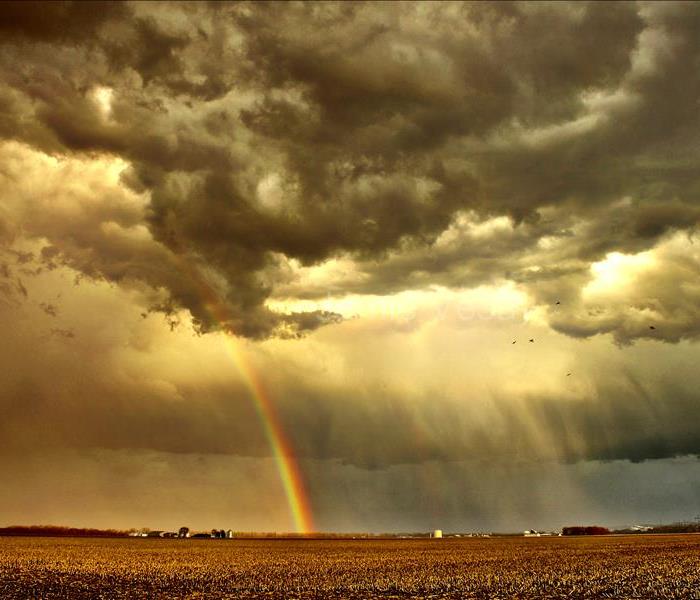 Here are some steps you can take to prepare your home ahead of the spring-thaw months to prevent common causes of water damage.
Here are some steps you can take to prepare your home ahead of the spring-thaw months to prevent common causes of water damage.
There is no way for a homeowner to completely prevent all water damage under every circumstance however there are steps you can take to prepare your home ahead of the spring-thaw months to prevent common causes of water damage.
- Read and understand your homeowner’s insurance
- Avoid storing valuable items in your basement.
- Install a basement pump or a water alarm
- Remove debris from window wells, gutters & downspouts
- Check for and repair leaks around doors and windows
- Inspect your foundation for cracks and repair any that you find to prevent water seepage
- Trim any trees or bushes away from your home
- Keep your roof in good shape, be sure to make regular repairs to prevent water leaks.
If your home/business experiences water damage, our franchise professionals are on standby 24 hours a day, 365 days a year to make it “Like it never even happened.”
Water Damage Effects and Risks
6/28/2019 (Permalink)
 Flood or water damage cleanup in Chesapeake
Flood or water damage cleanup in Chesapeake
Effects of Water Damage
Causes of Water Damage
We have seen many causes of water damage in Chesapeake. Clogged toilets, overflowing washing machines, broken dishwasher hoses, plumbing leaks, broken pipes and cracked foundations are just a few reasons for damage to homes and businesses. Floods from heavy rain where the ground can’t absorb it quick enough or storm surges from a Nor’easter have caused extensive water damage to our area residents. The water damage can be minor, or it can be major leading to destruction of the home or business. As soon as the water threat is over, immediate water damage cleanup is vital to helping to save your water-soaked furniture, carpet, rugs, clothing and other possessions.
Health Hazards
Acting quickly after water damage is very important and calling your local IICRC water damage cleanup and restoration professional, SERVPRO® of Chesapeake North will help to ensure a quick response and water damage recovery.
Moisture feeds mold and other organisms, both of which can cause serious health problems. Mold can grow after water damage with 48 hours. We know that cleaning up the water damage immediately can help mitigate the health effects for everyone in a commercial or home space.
If you have suffered a flood or water damage emergency, call your local SERVPRO® of Chesapeake North, available for you 24/7 every day.
How to Protect Against Water Damage
6/14/2019 (Permalink)
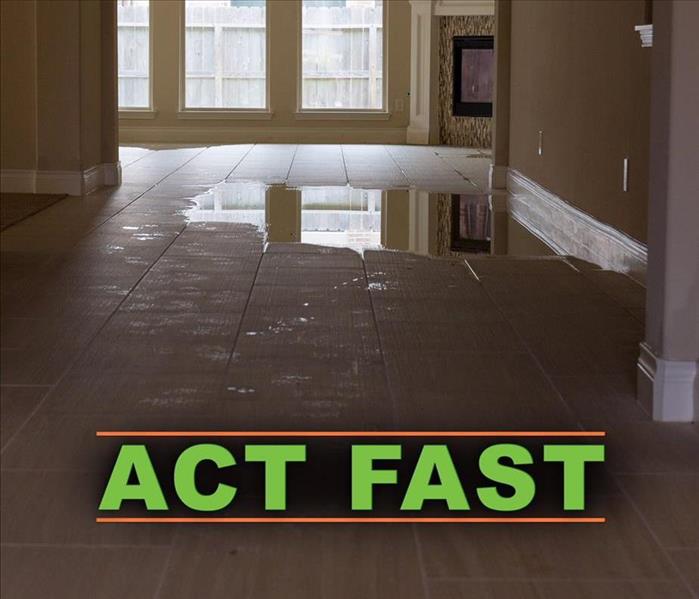 Water Damage Cleanup in Chesapeake
Water Damage Cleanup in Chesapeake
How to Protect Against Water Damage
Here are some steps to take to help minimize your risk.
It could be a flooded bathroom or a water heater leak in your attic, and you know that the water damage could be costly to repair. We’ve got some home improvement suggestions to help make water damage less likely.
- Replace old pipes. Home piping usually has a life span of 50 to 80 years. If yours are older, it’s a good idea to ask a plumber for an inspection. PVC pipes may need to be replaced every 25-40 years.
- Inspect your water heater. Water heaters usually need to be replaced every 10 years. Learn more about signs that you might need a new water heater.
- Update your windows and doors. Watertight options are available with new doors and windows. Wood windows should be cleaned, repainted and stained every so often. Cracks should be resealed, and old glazing compounds should be replaced as needed.
- Replace washing machine supply hoses. As part of a proactive maintenance plan, replace every 3 to 5 years.
- Regularly inspect your roof. Look for loose or missing shingles, or any sign of damage. While up there, inspect your gutters to make sure leaves and debris have been removed and that the drain spout is properly attached.
Water damage in Chesapeake? Call SERVPRO® of Chesapeake North at 757-465-9700.
Signs You Might Need a New Water Heater
6/11/2019 (Permalink)
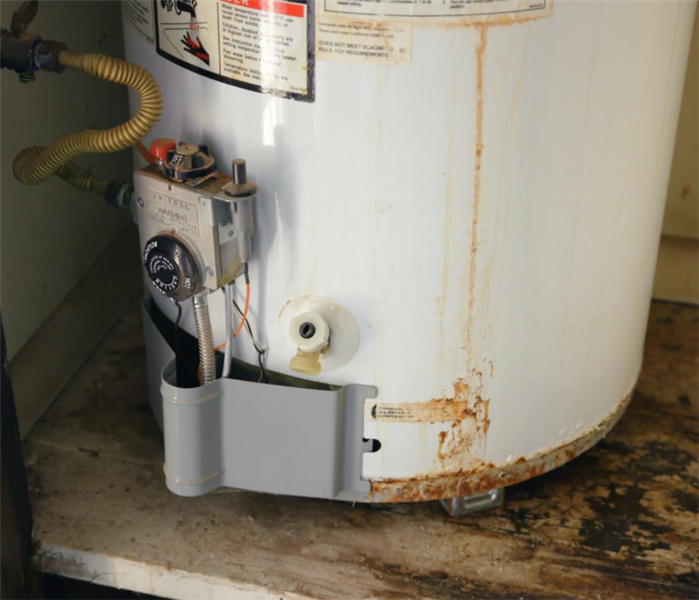 Water Damage Cleanup in Chesapeake
Water Damage Cleanup in Chesapeake
Signs You Might Need a New Water Heater
SERVPRO® of Chesapeake North gets emergency calls from homeowners whose water heaters have leaked onto their floors and even onto their ceiling and throughout their attic. Here are some signs that you might need a new water heater and ways to find out if you do. These may require a little periodic checking while others become obvious only after things have gone wrong.
- The water is not getting hot enough.
- The water is not getting hot at all. It could be that the pilot light is out, or the circuit breaker has been tripped, or worse the whole heating system is shot.
- The water is a rusty color or not clear running.
- The water has a strange metallic taste, which could mean that the inside of the tank is breaking down.
- The water heater is making loud popping and cracking noises that could mean the heating element is failing.
- There are signs of leakage around the water heater which indicates a major internal failure to the system. Make sure that the electricity or gas has been turned off to the system and that before replacing it, the unit has had a chance to cool completely.
We suggest that you should hire a professional to replace and install your water heater to be certain that the installation meets safety codes and is safe to use.
Water damage cleanup in Chesapeake? Call 757-465-9700.
Water Heater Safety. . . Get to Know Your Water Heater
2/28/2019 (Permalink)
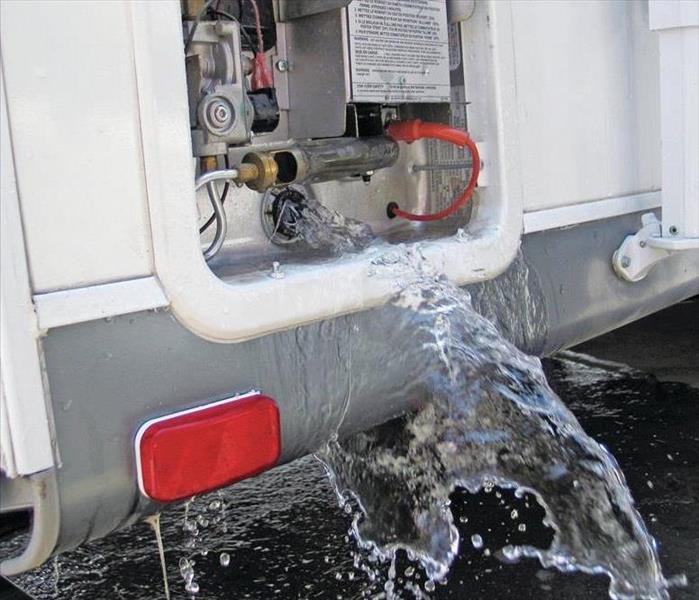 Water & Fire Damage Cleanup & Restoration in Chesapeake
Water & Fire Damage Cleanup & Restoration in Chesapeake
When it comes to your water heater, the old saying “out of sight, out of mind”, should not be taken lightly. Water heater failure can cause flooding and even a fire and the following water heater safety tips can help to prevent a catastrophe. Nationwide Insurance suggests that getting to know your water heater parts and routine maintenance can help to keep your water heater safe and help avoid a disaster.
Water heater parts
A residential water tank can hold 40 to 60 gallons and needs to withstand typically 50 to 100 psi, Steel tanks are tested to handle 300 psi and have glass liners to keep rust out of the water, and insulation to surround the tank. Other parts to become familiar include:
- A dip tube to let cold water into the tank
- A thermostat to control the temperature of the water that is inside of the tank
- A pipe to drain hot water out of the tank
- Heating elements like those found inside of an electric oven
- A drain valve to allow you to drain the tank to move it or replace the elements
- A temperature or release valve that helps keep the tank from exploding
- A sacrificial anode rod, screwed into the top of your water heater and protects your heater from rusting
Some important facts to remember about your water heater.
Pulling up on the pressure relief valve or temperature valve handle to make sure water flows freely out and stops when you let go of the handle can help prevent tanks from exploding and should be tested annually.
Temperature settings vary on residential tanks, but the right temperature is at least 120 degrees at the tap, which you can test with a meat or candy thermometer. This temperature helps to kill germs and prevent children from being scalded. When you go on vacation, set the temperature lower to save money and reduce risk of problems while away.
Venting is important as a poor draft can cause fumes and carbon monoxide to reenter a room instead of exiting. Make sure the vent goes straight up and out without any dips and is the same diameter as the tank’s draft diverter.
Flushing the hot water through the drain valve annually will help to remove sediment buildup.
Extinguish the pilot light when handling flammable liquids or aerosol. If the water heater is in the garage, raise it to that the pilot light is 18” above the floor. This is to help prevent ignition of gasoline vapors that collect near the floor.
Strapping your water heater can help prevent it from falling over which could sever a gas line and cause an explosion.
Insulation may help reduce heat loss on the hot water pipe and “sweating” on the cold-water pipe.
Should you need water or fire damage cleanup and restoration in Chesapeake, call your 24-hour emergency service company, operating since 1996.
When Your Stuff Gets Wet
6/27/2018 (Permalink)
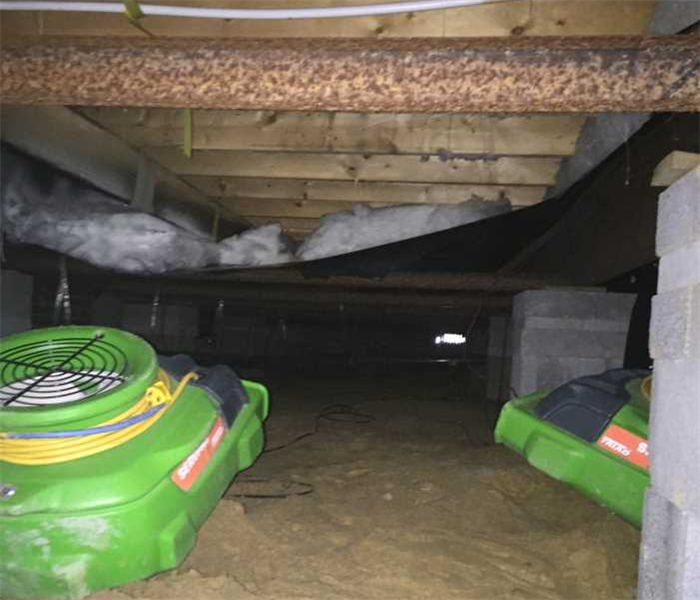 Water Damage Restoration in Chesapeake
Water Damage Restoration in Chesapeake
When Your Stuff Gets Wet
Water Damages your contents and things too. SERVPRO Chesapeake North has seen its share of water damage. The damage can happen from a leaking pipe between the wall, a leaking toilet, a dishwasher relief valve that fails, a refrigeration line fail, a water heater leak, an HVAC system ceiling leak and of course havoc from mother nature.
Most often our first thought is about damage to the floors or to the ceiling, or even the walls. Then the realization that your contents, your treasures, your projects, your books have been damaged too.
We are your Emergency call to action experts when disaster strikes your home or business 24/7.
For over 20 years, SERVPRO of Chesapeake North helps to make it#LikeItNeverEvenHappened #HeretoHelp #SERVPRO8233
Salvaging Personal Belongings
6/14/2018 (Permalink)
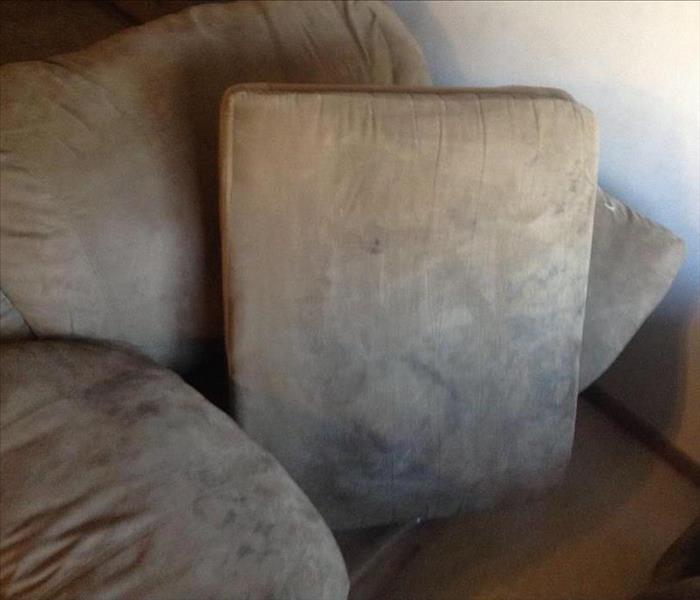 Water Damage Chair Gets Cleaned
Water Damage Chair Gets Cleaned
One of the most common topics after a client suffers water damage, is how and what can be salvaged and restored. Unfortunately, there is no clear-cut answer. Every water damage is unique and case by case. Once we have received notice of your water loss and the source has been stopped, our SERVPRO specialists will identify the source to begin the restoration process.
Here are some things to consider:
Identity the Type of Water Damage
Determining what type of water has damaged your personal belongings is part of our inspection process. In the restoration industry we categorize water as clean water, a category 1, gray water is category 2 and black water is category 3.
SERVPRO of Chesapeake has the Esporta technology that cleans all these water damage categories including category 3 contaminated water.
Porous vs Non-Porous Materials
Porous materials such as fabrics, wood, and paper are very good at retaining water. Porosity also means the increase in the chance of other dangers like mold growth, and even damage beyond repair or restoration. Here in lies the case by case scenario. Porous materials such as marble, metal, and porcelain - among others - usually have no problem in being restored because bacteria and mold are not usually able to root to their surface.
The Amount of Time the Water has Saturated Your Belongings
Another factor that will come into the equation of determining what can and cannot be saved is how long the materials have been wet. The longer a porous item sits in water, the more difficult to bring it back to its preloss state. The perfect example of this is wooden furniture. Belongings that are left damp or wet and exposed to the elements are at a greater risk for mold growth and may not be salvageable. Acting quickly and calling your local SERVPRO as soon as you discover the water damage is key to restoration success.
Restoration or Replacement Costs
SERVPRO of Chesapeake North will always try to restore your water damaged items to their preloss condition unless they are beyond restoration.
We know that your belongings are what help to make your home a home. Our restoration helps to save you and your insurance company money, not to mention prevents landfill pollution. If restoration is not an option, then replacement is usually the next option.
When you hire the professionals at SERVPRO of Chesapeake North, you know that your water damage has been assessed and your belongings have been analyzed for the best course of action to help make it “Like it never even happened.”
Best Smart Water Leak Detectors of 2018
5/31/2018 (Permalink)
 2018 Smart Water Detector Pick
2018 Smart Water Detector Pick
The best smart water leak detectors of 2018 were picked recently by Reviewed.com and shared on This Old House. The best were tested for responsiveness and ease of setup, put in simulated leaks and even submerged in water.
At SERVPRO of Chesapeake North we know all about water damage cleanup and restoration. Pipes freeze, dishwashers and refrigerators leak, and HVAC systems leak in the attic. You need to keep your home protected against water and flood damage.
New technology can send alerts to your phone and notify you even when you are hundreds of miles away that you have a home or business water leak or flood. The best of the best recommended was the Honeywell Lyric water leak and freeze detector. . . read more about water and flood sensors.
Keeping Kids Safe Near Water
5/31/2018 (Permalink)
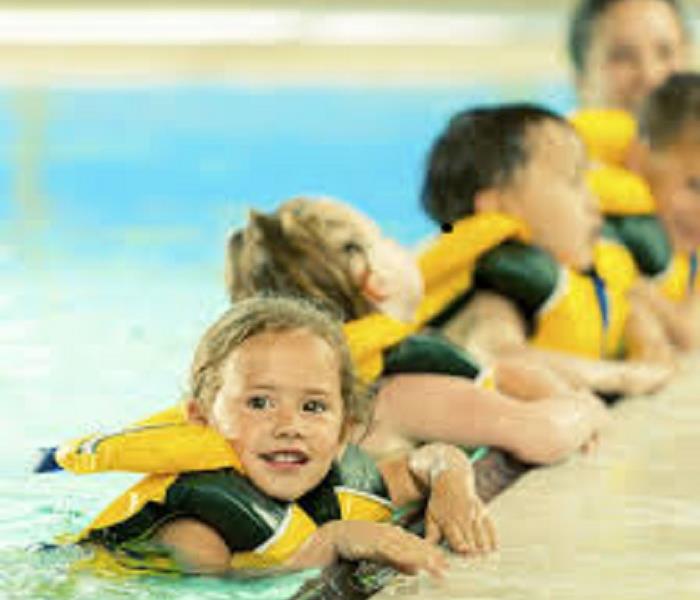 Keeping Kids Safe Near Water
Keeping Kids Safe Near Water
As the warmer weather arrives, and summer time fun begins, parents and children must be alert and prepared when it comes to pool and water safety.
The most important tip from children's heath care professionals is for parents to always keep their eyes on their kids around water whether at a pool, a water park or at the beach.
Swim lessons are powerful and important and recommended instead of depending on floating devices for safety.
When choosing a life jacket, make sure that the life jacket is Coast Guard certified. The label on the back will give you weight parameters and who the life jacket is suited.
Remember to never rely on noodles, or other flotation devices to save your child's life.
Summer Safety Tips on Water Safety
Four Significant Ways to Prevent Water Damage
5/7/2018 (Permalink)
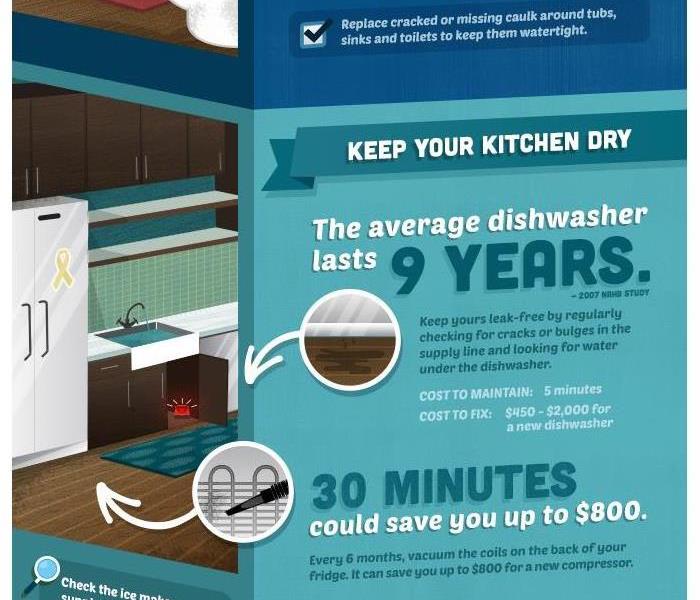 Water Damage Prevention in Chesapeake
Water Damage Prevention in Chesapeake
The Insurance Institute for Business & Home Safety reminds us that those annoying leaky faucets if left unchecked and unfixed, could cost thousands of dollars in damage. USAA suggests (4) significant ways to prevent water damage.
- Inspect Your Attic Leaky Roofs are the #1 leading cause of water damage. Musty smells, water stains on the ceiling or floor, missing shingles or damp insulation.
- Check Your Bathroom from cracked or missing caulk around tub, sinks, and toilets. Water damage from one toilet can cost $2,000-10,000.
- Keep Your Kitchen Dry by checking your refrigerator ice maker & dishwasher supply lines for kinks or cracks. Check under the dishwasher for water. Vacuum the coils on your frig every 6 months. Proper maintenance can help your fridge to last 13 years.
- Watch Over Your Utility Room as 75% of water heaters fail before they're 12 years old and check your washer for leaks, cracks & bulges. Replace supply lines every 5 years with steel braided hose.
Every water damage situation is different and requires a unique solution, but the Water Damage Restoration Process stays the same.
Have Water or Flood Damage? Call us Today- 757-465-9700 #AlwaysHereToHelp #LikeItNeverEvenHappened #WaterDamageInChesapeake
Flood Water in Chesapeake
2/22/2018 (Permalink)
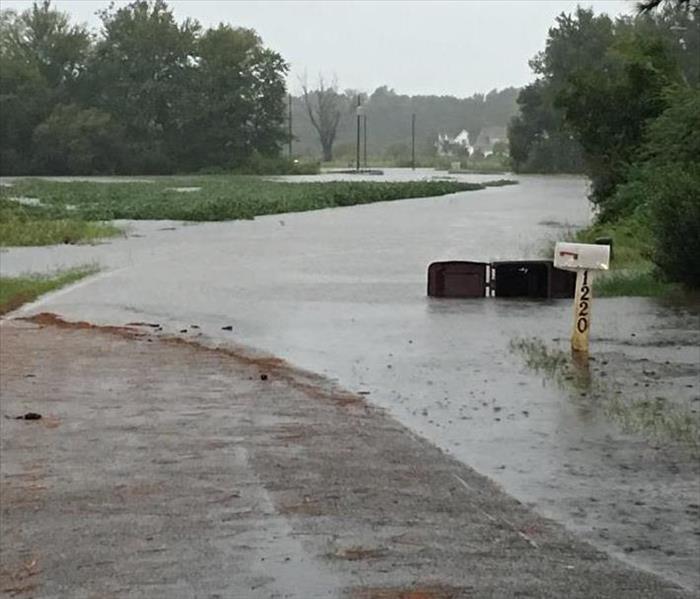 SERVPRO of Chesapeake North, 757-465-9700
SERVPRO of Chesapeake North, 757-465-9700
Floods are one of the most common and widespread natural disasters in the United States. Your location no longer seems to be a factor-there is always potential for flood damage.
Fema.gov reports that in the last 5 years, all 50 states have experienced floods or flash floods. It’s not a matter of if, but when and FEMA reports that nearly 20% of all flood insurance claims come from moderate-to-low risk areas, and even just one inch of flood damage in an average home can cost you up to $27,000.
#TheAmericanRed Cross claims that floods cause more damage in the U.S. every year than any other weather-related disaster. Here are some tips they advise to follow:
- Stay away from floodwaters. If you come up on a flowing stream where water is above your ankles, Stop, Turn around, and go another way.
- If you approach a flooded road while driving, the same holds true. If you are in your car and waters are rising rapidly, get out of the car quickly and move to higher ground.
- Keep children out of the water. Children may not recognize contaminated water and lack judgment.
If your home or business is affected by a flood, SERVPRO of Chesapeake North is your water damage restoration company. Even minor floods have the potential to cause major damage to a structure if not treated properly and quickly.
Cleanup can be overwhelming and that’s why the “SERVPRO® System is prepared to handle any size disaster. When fire and water take control of your life, let your local SERVPRO of Chesapeake North help you take it back.
Do you have water damage in Chesapeake call us at 757-465-9700.
Your Chesapeake home is your largest investment, what happens when disaster hits?
7/20/2017 (Permalink)
 SERVPRO® of Chesapeake North 757-465-9700
SERVPRO® of Chesapeake North 757-465-9700
Your home is more than likely the biggest investment that you will ever make and one that holds a lifetime of memories.
What happens if you wake up to see 2 inches of water in your kitchen? What would you do? Do you know who you would call?
We are SERVPRO® of Chesapeake and we have been serving homeowners and businesses like you since 1967.
As a leader in the field of water damage repair and restoration, our crews are trained to help you when disaster strikes, to help walk you through the drying process and help to make it #LikeItNeverEvenHappened.
If disaster strikes your home, be sure to remember to call SERVPRO® of Chesapeake at 757-465-9700
#SERVPRO8233 #NoWorries #SERVPRO
Faster to your Chesapeake Water Damage Emergency
6/14/2017 (Permalink)
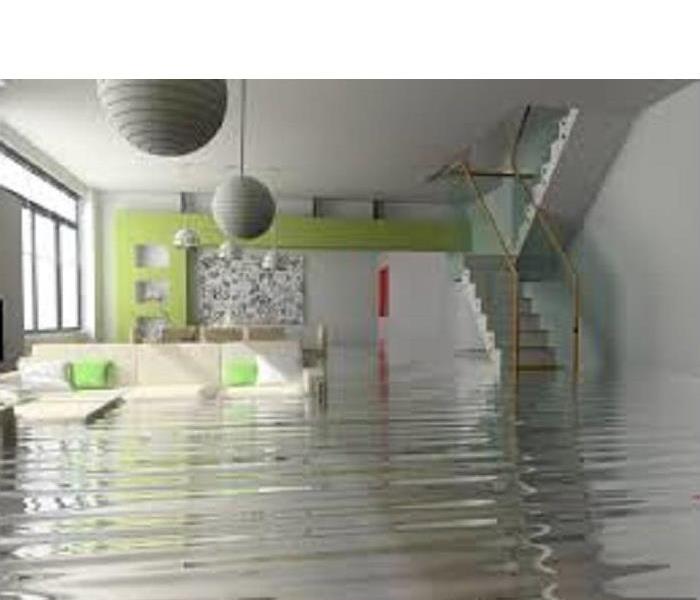 SERVPRO® of Chesapeake North provides 24 hour fire and water damage restsoration service in Chesapeake
SERVPRO® of Chesapeake North provides 24 hour fire and water damage restsoration service in Chesapeake
SERVPRO® of Chesapeake is available 24 hours a day for water emergencies, large or small. When you are dealing with water damage, immediate action is crucial. A delay of just a few hours can greatly increase the severity of the water damage.
We Answer the Phone Ready to Help
Call Today - 757-465-9700
We understand that when you call us, you may be feeling confused, stressed, and vulnerable. You need an expert to guide you through this crisis. SERVPRO® of Chesapeake has the specific water damage training and experience to help you through this tough time. We specialize in water damage restoration—in fact, it's the cornerstone of our business.
What to Expect
When you call, we will ask several questions regarding your water damage emergency. These questions will help us determine what equipment and resources to bring, including how many trained SERVPRO® Professionals may be needed.
Our SERVPRO Representative will ask several questions:
- Your name and contact information
- Your insurance information (if applicable)
- The street address of the water-damaged home or business
- When did the flooding or water damage occur?
- What caused the water damage (if known)?
- Is there electricity available (on-site)?
About SERVPRO® of Chesapeake
SERVPRO® of Chesapeake specializes in the cleanup and restoration of residential and commercial property after a fire, smoke or water damage event. Our staff is highly trained in property damage restoration. From initial and ongoing training at SERVPRO’s corporate training facility to regular IICRC-industry certification, rest assured our staff is equipped with the knowledge to restore your property.
Meet Our Crew
Certifications
- CMR - Council-certified Microbial Remediator
- OSHA - 10-hour General and/or Construction Industry Training Program
- ASD - Applied Structural Drying Technician
- LCT - Leather Cleaning Technician
- RRRP - Lead-Based Paint Activities and Renovation
- VSMR - Ventilation System Mold Remediators
- IICRC Certified Firm
- OCT - Odor Control Technician
- WRT - Water Damage Restoration Technician
- AMRT - Applied Microbial Remediation Technician
- ECTP - Employee Certification Training Program
- UFT - Upholstery & Fabric Cleaning Technician
- OSHA - 30-hour General and/or Construction Industry Training Program
- CCT - Carpet Cleaning Technician
- RRT - Carpet Repair & Reinstallation Technician
- ASCS - Air Systems Cleaning Specialist
- OSHA - Other Training
- SRT - Fire & Smoke Damage Restoration Technician
The Do's and Don'ts of Water Damage
4/11/2016 (Permalink)
 A leaky faucet could be a sign of water damage.
A leaky faucet could be a sign of water damage.
Sometimes you never know when water damage is going to occur. With these tips, you can be sure you are prepared for any water damage situation.
Water Damage From Clean Water
DO:
- Shut off the source of water if possible or contact a qualified party to stop the water source.
- Turn off circuit breakers for wet areas of the building, when access to the power distribution panel is safe from electrical shock.
- Remove as much excess water as possible by mopping and blotting.
- Wipe excess water from wood and furniture after removing lamps and tabletop items.
- Remove and prop up wet upholstery cushions for even drying.
- Place aluminum foil or wood blocks between furniture legs and wet carpeting.
- Remove to a safe, dry place any paintings, art objects, computers, documents and other materials that are valuable or sensitive to moisture.
- Use wooden clothespins to keep furniture skirting off damp floors.
- Hang draperies with coated hangers to avoid contact with wet carpeting or floors.
- Hang furs and leather goods to dry separately at room temperatures.
DON’T:
- Enter rooms with standing water where electrical shock hazards may exist.
- Enter affected areas if electrical outlets, switches, circuit breakers or electrical equipment are exposed to water.
- Always avoid electrical shock hazards.
- Leave books, newspapers, magazines or other colored items on wet carpets to cause staining.
- Use your household vacuum cleaner to remove water, possibly causing electrical shock or damage to the vacuum cleaner.
- Use TVs or other appliances while standing on wet carpets or floors, especially not on wet concrete floors.
- Turn on ceiling fixtures if ceiling is wet or enter rooms where ceilings are sagging from retained water.
Water Damage From Contaminated Water
DO:
- Avoid all contact with sewage and items contaminated by sewage.
Wash your hands thoroughly after contact with contaminated items.
DON’T:
- Spread contaminated water by walking unnecessarily on damaged or wet areas.
- Turn on the HVAC system if there is a possibility of spreading contaminated air.
- Use household fans to dry the structure and spread contaminants.
- Use products for personal hygiene and cleanliness if exposed to the contaminated areas.
Always call SERVPRO of Chesapeake when you experience any water damage. Call us at (757) 465-9700.
Chesapeake Lawn and Garden Month
4/7/2016 (Permalink)
April is National Lawn and Garden Month and the team here at SERVPRO® of Chesapeake have a few gardening and lawn tips that may help keep your yard and home protected against flooding and water damage.
Lawns
Homeowners can begin with the size and care of lawns. Rather than maintaining a large carpet of green through the use of pesticides and herbicides, consider reducing the size of your lawn by 10% and allow your landscape to be a bit more natural. You can help prevent soil erosion by using native plants in your landscape that help hold soil in place and filter storm water. As a bonus, your lawn and garden will be greener during the dry days of summer, as native plants are more drought resistant than many popular non-native lawn grasses.
You can take a few simple steps to make your lawn healthier and better able to absorb rainwater when it falls:
- Use an organic fertilizer early each spring
- Set your mower to 3”, not anything lower (Cutting too short results in decreased root growth. More roots mean more water is absorbed and runoff is reduced.)
- Water infrequently but deeply
- Use hand tools to remove individual weeds
Rain Gardens
Even owners of small pieces of property can help prevent flooding through the use of a rain garden. A rain garden is a low-lying vegetated depression (typically 3 to 6 inches deep) with absorbent soils that temporarily collect storm water runoff from impervious surfaces and allow the runoff to slowly percolate into the soil.
When building a rain garden, plants with the highest wet-soil tolerance should be placed in the center, since those at the edge will drain fairly quickly while the middle remains submerged.
Large or small, rain gardens should be planted with native plants. Using native plants is best whenever possible, as they require little to no watering in between rainfall, making a more low-maintenance yard and cutting down on the need for harmful pesticides. As a general rule, any plant described as Japanese, Oriental, English, etc. is obviously not native to North America and should be avoided.
Some common native flowers are black-eyed Susan, coneflower and wild columbine. Native trees include sweetgum, red maple, Eastern redbud and American holly. But these are just a few of the hundreds of plants that are native to our region. The best way to figure out which plants are native is to explore a book or online guide that describes native plants. Here are three excellent resources to help you get started:
- The U.S. Fish & Wildlife Service’s Native Plants for Wildlife Habitat and Conservation Landscaping: Chesapeake Bay Watershed
- The Native Plant Center, an online version of the U.S. Fish & Wildlife Service’s native plant guide
- The Lady Bird Johnson Wildflower Center’s online Plants of Chesapeake Bay collection
Here at SERVPRO of Chesapeake, we believe in prevention first!
*Sources: Raritan Headwaters, Lot Plans.
Frozen Pipes...But not Broken Yet
2/10/2016 (Permalink)
Most people, when they think of frozen pipes in their homes, automatically think of broken pipes, spewing a huge mess that soaks carpet, subfloors, walls and more...requiring the attention of their water damage professional.
But many times, a frozen pipe doesn't necessarily become a broken pipe. You might have experienced this yourself: you go into a bathroom, during a really cold part of winter, turn on the faucet and nothing comes out. Or perhaps only a trickle dribbles into the sink.
This is a nuisance that must be dealt with quickly, before the pipe actually breaks and creates a larger problem.
Preventing this from ever happening is the best course of action. Here are some things you can do when temperatures dip well below freezing:
1. Take control of the temperature in your home. Some, especially when leaving for a few days, will set the temperature lower to save money. But keep your home at 60 degrees or higher. Installing a thermostat that you can control remotely from you smartphone means you can monitor your home 24/7 while traveling.
2. While home, when temperatures are extremely cold, open kitchen and bathroom cabinets to allow warmer air to flow among pipes and, for problem sinks that have had their pipes freeze in the past, or that you feel might freeze, allow a slow trickle of water to run.
3. Keep garage doors closed. If you have water supply pipes in the walls or ceiling of your garage immediately shut the garage door so the heat from the engine can help warm the garage.
But if a frozen pipe does happen, your only recourse is to thaw it. This might take some time. Warm up your house, and use safe heat such as a hair dryer, to warm the area where the pipe is frozen. Do not use a blowtorch, kerosene or other heat source fired by fuel and don't use open flames. If you can't determine where the frozen pipe is, a local plumbing company can help.
And of course, if the worst happens and a pipe does break, call us!
Leaks Happen - Be Ready
9/3/2015 (Permalink)
You know the normal sound your home makes.
The air conditioner kicking on as the dog days of summer begin. The heating system starting up on a cold, winter evening. The creak of a loose floorboard as someone rises early in the moring.
What you don't normally hear - and you do not want to hear- are the sounds of spraying water from a broken pipe hose, or a malfunctioning hot water tank or water filter system. Even worse is when this happens when you aren't home and upon arrival you wade through inches of waer on the floor, or duck from the dripping water from an upstairs leak.
Statistics say water damage claims are among the highest with insurance companies. You need to act quickly. #1 concern is to think safety first.
Next, find the water turn-off valve and stop the flooding. Many homeowners aren't sure where the water turn-off valve is located. Now is the time to figure that out, and even put a tag on it so it is easy to find, especially in the dark or in the beam of a flashlight. Don't delay...find that valve and mark it!
It's always best to be prepared. Contact SERVPRO of Chesapeake and get the info you need to be safe...just in case.






 24/7 Emergency Service
24/7 Emergency Service

